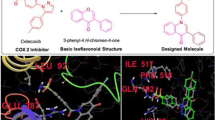Abstract
The modes of action of TxA2 antagonists and COX-2 inhibitors were studied utilizing flexible ligand docking with postdocking minimization and ab initio interaction energy calculations. The resulting increased understanding of their binding interactions led to the design of a lead compound with chemical moieties that allowed efficient binding to both the thromboxane receptor and the COX-2 enzyme. This compound is derived from allicin, a natural component of garlic, and is a good starting point for the development of anti-inflammatory drugs with fewer side effects or improved cardiovascular drugs.

Lead compound design for TPR/COX dual inhibition











Similar content being viewed by others
References
Wang LH, Kulmacz RJ (2002) Prostaglandins Other Lipid Mediat 409:68–69
Fu JY, Masferrer JL, Seibert K, Raz A, Needleman P (1990) J Biol Chem 265:16737–16740
Whittle BJ (2003) Fundam Clin Pharmacol 17:301–313
Grosser T et al (2006) J Clin Invest 116:4–15
Selg E, Buccellati C, Andersson M, Rovati GE, Ezinga M, Sala A, Larsson AK, Ambrosio E, Lastbom L, Capra V, Dahlen B, Ryrfeldt A, Folco GC, Dahlen SE (2007) Br J Pharmacol 152:1185–1195
Rovati GE, Sala A, Capra V, Dahlen SE, Folco G (2010) Trends Pharmacol Sci 31(3):102–107
Peng C, Ayala PY, Schlegel HB, Frisch MJ (1996) J Comput Chem 17:49–56
Peng C, Schlegel HB (1994) Israel J Chem 33:449–457
Petersson GA, Al-Laham MA (1991) J Chem Phys 94:6081–6090
Petersson GA, Bennett A, Tensfeldt TG, Al-Laham MA, Shirley WA, Mantzaris J (1988) J Chem Phys 89:2193–2218
Liu ECK, Abell LM (2006) Anal Biochem 357:216–224
Gierse JK, Hauser SD, Creely DP, Koboldt C, Rangwala SH, Isakson PC, Seibert K (1995) Biochem J 305:479–484
Kurumbail RG, Stevens AM, Gierse JK, Mc Donald JJ, Stegeman RA, Pak JY, Gildehaus D, Miyashiro JM, Penning TD, Seibert K, Isakson PC, Stallings WC (1996) Nature 384:644–648
Kurumbail RG, Stevens AM, Gierse JK, McDonald JJ, Stegeman RA, Pak JY, Gildehaus D, Miyashiro JM, Penning TD, Seibert K, Isakson PC, Stallings WC (1997) Nature 385:555 (erratum)
Hirata M, Hayashi Y, Ushikubi F, Yokota Y, Kageyama R, Nakanishi S, Narumiya S (1991) Nature 349:617–620
Kiefer F, Arnold K, Kunzli M, Bordoli L, Schwede T (2009) Nucleic Acids Res 37:D387–D392
Kopp J, Schwede T (2004) Nucleic Acids Res 32:D230–D234
Friesner RA, Banks JL, Murphy RB, Halgren TA, Klicic JJ, Mainz DT, Repasky MP, Knoll EH, Shaw DE, Shelley M, Perry JK, Francis P, Shenkin PS (2004) J Med Chem 47:1739–1749
Halgren TA, Murphy RB, Friesner RA, Beard HS, Frye LL, Polland WJ, Banks JL (2004) J Med Chem 47:1750–1759
Friesner RA, Murphy RB, Repasky MP, Frye LL, Greenwood JR, Halgren TA, Sanschagrin PC, Mainz DT (2006) J Med Chem 49:6177–6196
Schrödinger LLC (2009) Maestro. Schrödinger LLC, New York
So SP, Wu J, Huang G, Huang A, Li D, Ruan KH (2003) J Biol Chem 278(13):10922–10927
Yamamoto Y, Kamiya K, Terao S (1993) J Med Chem 36:820–825
Nakahata N (2008) Pharmacol Ther 118:18–35
Funk CD, Furci L, Moran N, Fitzgerald GA (1993) Mol Pharmacol 44:934–939
Selg E, Buccellati C, Andersson M, Rovati GE, Ezinga M, Sala A, Larsson AK, Ambrosio E, Lastbom L, Capra V, Dahlen B, Ryrfeldt A, Folco GC, Dahlen SE (2007) Brit J Pharmacol 152:1185–1195
Rowlinson SW, Crews BC, Lanzo CA, Marnett LJ (1999) J Biol Chem 274(33):23305–23310
Rowlinson SW, Kiefer JR, Prusakiewicz JJ, Pawlitz JL, Kozak KR, Kalgutkar AS, Stallings WC, Kurumbail RG, Marnett LJ (2003) J Biol Chem 278(46):45763–45769
Bouaziz-Terrachet S, Toumi-Maouche A, Maouche B, Tairi-Kellou S (2010) J Mol Model 16:1919–1929
Mais DE, Mohamadi F, Dube GP, Kurtz WL, Brune KA, Utterback BG, Spees MM, Jakubowski JA (1991) Eur J Med Chem 26:821–827
Gupta AK, Gupta RA, Soni LK, Kaskhedikar SG (2008) Eur J Med Chem 43:1297–1303
El-Sabban F (2009) J Chinese Clin Med 41(5):288–294
Author information
Authors and Affiliations
Corresponding authors
Rights and permissions
About this article
Cite this article
Krishna, A., Yadav, A. Lead compound design for TPR/COX dual inhibition. J Mol Model 18, 4397–4408 (2012). https://doi.org/10.1007/s00894-012-1435-y
Received:
Accepted:
Published:
Issue Date:
DOI: https://doi.org/10.1007/s00894-012-1435-y




